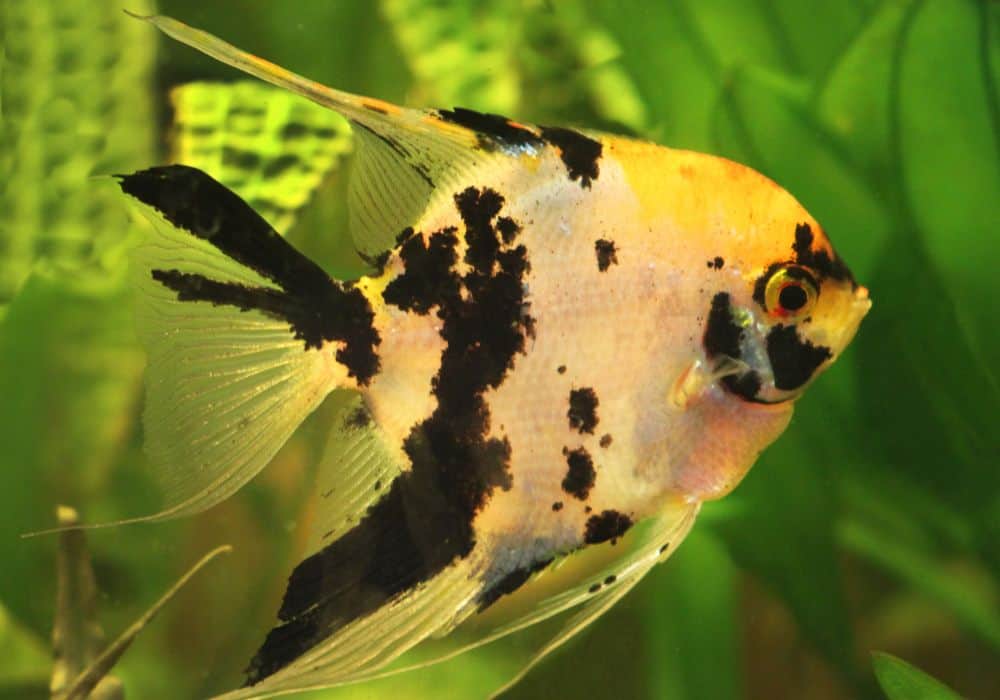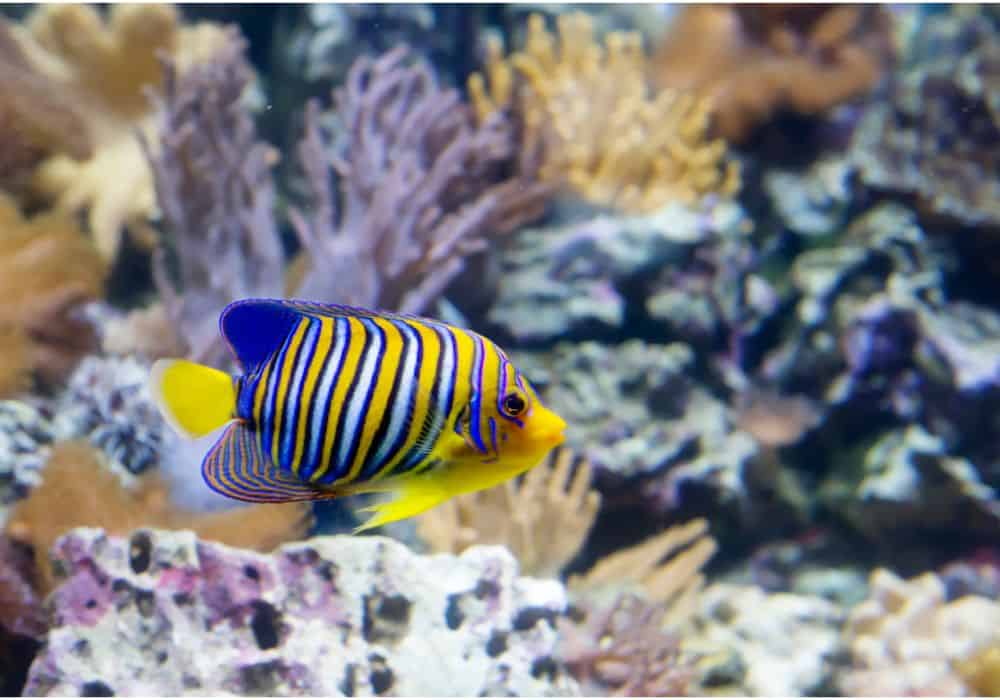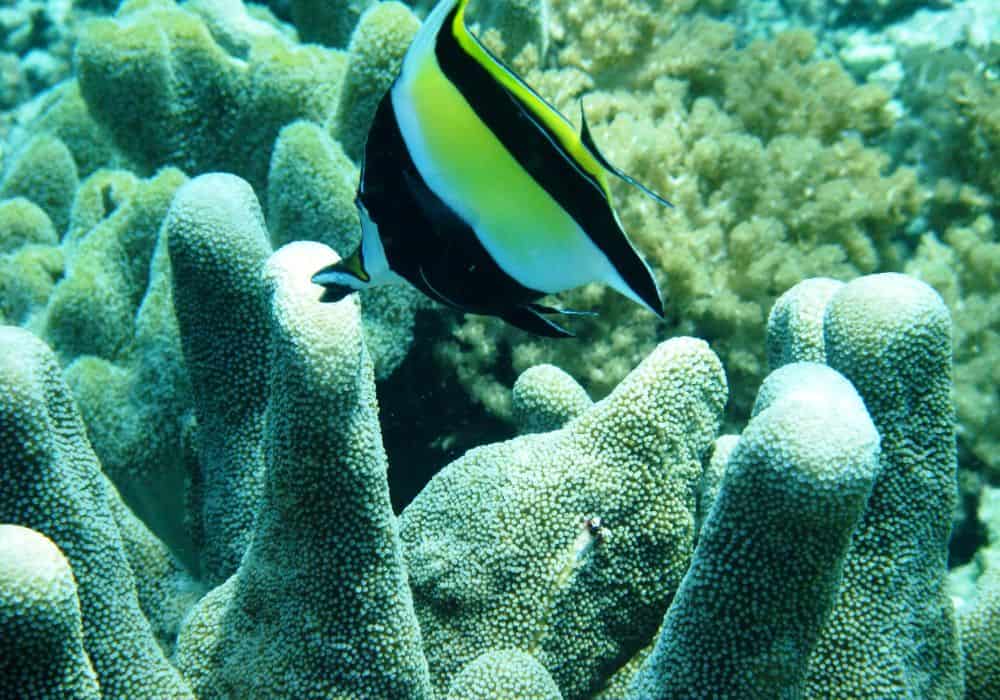Angelfish are a beautiful species of fish that can be found in various aquariums. Fish enthusiasts often keep them as pets, but it is important to know how to look after them and the ideal conditions they should be kept in.
Have you recently added an angelfish to your aquarium but have no idea what they eat? Are you interested in learning more about your angelfish? Read on to find out about their dietary needs, both as pets and in the wild, how often they eat, and some interesting facts.
General Information About Angelfish
Angelfish are small tropical freshwater fish that come in a variety of colours. The Latin name for an angelfish is pterophyllum, and they originate from rivers such in South America such as the Amazon River. This means they prefer warmer water and need plants and vegetation.
Though there are several species of angelfish, and three in particular are most suited to aquarium life. These are common angelfish, altum angelfish, and Leopold’s angelfish. The first of the three are the most popular because they’re easy to find in the aquarium trade.
Angelfish can be distinguished from other similar fish by the long whisker-like spine protruding from each cheek. They can grow to be up to 18 inches long, depending on the species, but most adult angelfish are more likely to be up to 6 inches long.
What do Angelfish Eat?
Angelfish are omnivores, meaning they eat both plants and meat, including algae. Therefore, you should feed them different foods that adhere to this diet. They tend to eat more meat than plants, so make sure the ratio of meat to plants is higher.
The following types of foods are suitable for angelfish, according to FishTankMaster:
Flakes and Pellets
High-quality flakes and pellets are a staple for freshwater angelfish living in a tank. Many pet stores sell various types of fish food, but you should get those that are suitable for tropical fish, specifically cichlids.
You should also make sure you read the ingredients to make sure that the flakes or pellets have a high protein content. In addition, plant-based spirulina flakes will give your angelfish the vitamins they need without the need to feed them additional vegetables.
It is the ideal type of food to be given each day, but you should also add other foods from this list to give them a more diverse diet that is similar to what they eat in the wild.
Live Foods
Angelfish enjoy eating a range of live foods that they would usually find in the wild. Some people may be uncomfortable with feeding a fish live food, or struggle to find a supply of live food, so there are alternatives available.
However, if you are fine with it, then there are three creatures in particular that are popular with angelfish: brine shrimp, black worms, mealworms, and bloodworms. If you decide to purchase live food, ensure that they are from a reputable source such as a trusted pet store.
This is because some live foods can contain parasites or harmful bacteria that can infect your angelfish and make them seriously ill. They may also spread to the other fish in the aquarium and cause a widespread outbreak of disease.
Vegetables
Angelfish can eat a range of vegetables, so long as they are properly prepared. A favourite of most species are cucumber and zucchini, but as with people, angelfish have their own personal preferences when it comes to food.
You can trial some different vegetables to see which ones your angelfish is most partial to. Make sure to peel and cut them up very small so that they can be digested easily. A vegetable that has proven to be popular with angelfish are shelled boiled peas.
Frozen Foods
Frozen foods are a more convenient and perhaps more humane way to feed angelfish. You can freeze live foods such as blood worms, brine shrimp, and plankton and keep them frozen for a long period of time before giving them to the fish.
You could also try freezing a beef heart, as some angelfish enjoy that, but it would have to be shredded into small pieces for easy digestion. Before giving a fish any frozen food, you must first defrost it in a container of water taken from the aquarium and stir before serving.
Freeze Dried Foods
Freeze dried foods are gaining popularity because they are extremely unlikely to contain any bacteria or parasites thanks to the freeze-drying process. However, the same process means that the food becomes less nutritious but it’s a good option to make their diet more diverse.
Again, you must defrost the food in a container of aquarium water before giving it to them. You can freeze dry brine shrimp and blood worms, so this is the ideal type of ‘live’ food if mixed with vitamin-enhanced flakes or pellets.
What do Angelfish Eat in the Wild?
Angelfish living in their natural habitat eat small crustaceans and worms that can be found at the bottom of the river. Sometimes, they will also eat different types of insects and even small fish!
Angelfish are more likely to lay eggs for breeding in the wild, but sometimes they eat their own eggs instead. If the eggs are fertilized and hatch, then the diet of angelfish fry (baby angelfish) differs from that of adult angelfish.
They cannot swim at first and will stay around the spot they hatched. They eat the yolk from the egg they hatched from for the first few days, then feed on the leftovers from the adult angelfish or much smaller portions of the same food until they are fully grown.
They can also eat newly hatched brine shrimps as newborns, but this is unlikely to happen in the wild unless the parent angelfish provide them, or they have hatched very close to some brine shrimp eggs.
Young angelfish will eat more frequently than adult angelfish, so they are more likely to spend time foraging for the above foods.
How Often Should You Feed Angelfish?
The amount you feed captive angelfish depends on their age. Young angelfish need more food because they are growing, so should be fed 3-4 times a day. Adult angelfish require less, so you should feed them 2-3 times a day.
The feeding schedule is very similar for wild angelfish, but they forage and hunt for their food, so it isn’t always guaranteed. Luckily, it has been proven that angelfish can go without food for an average of 5 days, but again it depends on their age.
Juvenile angelfish can go up to 3 days without food, whereas adult angelfish can last up to a week. In captivity, this is rarely an issue, but if you go on holiday and forget to feed them for a few days, chances are they’ll be fine.
How Much Should You Feed Angelfish?
In general, you should feed any aquarium-based fish the amount that they can eat in 2 minutes. For new fish or amateur owners, you will have to experiment with fish food flakes to see how much they can consume in that time frame.
If they finish all the flakes long before the time runs out, then you haven’t given them enough. If there are still flakes left after 2 minutes, then you gave them too much. This rule applies to any food, whether it is live, frozen, or flakes.
Once you know what the optimal amount to feed them is, adhere to the schedule above. Make sure you provide your angelfish with a diverse, mineral rich diet and change what you feed them at least once every two days to keep them healthy.
It is also important to only give them food that you know is safe, as like most fish, angelfish will eat anything in sight. They will also eat constantly if given the chance, so make sure they don’t have access to an unlimited supply to avoid overfeeding and associated issues.
Aquarium Requirements
Angelfish need a certain type of environment to successfully thrive in an aquarium. They require at least a 55-gallon tank that is tall as they have long, thin bodies. Water flow should mimic the gentle flow of a river, and the water temperature needs to be between 25C-29C.
The water should be filtered and maintained at a pH of 6.8 and 7.8. It should be changed by either 10% weekly or 25% every fortnight. Water hardness should be at 54 to 145ppm, or 3 to 8dKH. This means that the water must be moderately hard.
If any of these factors are not met, the fish will fail to thrive. The first sign of this is a loss of appetite, so if your angelfish suddenly stops eating or eats less than usual, check the water to make sure everything is as it should be. If not, adjust immediately.
The tank should be lined with gravel as they like to forage along the bottom for any scraps of food they may have missed. Make sure the gravel isn’t too big as the fish may choke on it, but also isn’t so small that it may be swallowed.
There should be various large leaf plants and floating pieces of driftwood to decorate the tank. Wild angelfish like to reside in shady parts of the river, so this also mimics their natural habitat and gives them a place to hide away and explore.
They can live with an assortment of other freshwater tropical fish such as tetras, rainbowfish, and catfish, but be aware that they can be aggressive and may attack their tank mates, including those of their own species.
Interesting Facts About Angelfish
- They will eat smaller fish – not because of their aggressive nature, but because they will eat anything they can fit in their mouths.
- They will eat constantly if given the opportunity, which is why it is so important to feed them on a schedule when in captivity.
- They are more likely to breed in the wild, as captive angelfish lose the breeding instinct and tend to eat their eggs and even their own offspring.
- It is rare to have a wild angelfish in an aquarium; most pet angelfish are born and raised in captivity.
- Breeders will encourage captive angelfish to lay eggs on a piece of slate, then after fertilisation, the eggs are removed and placed into a separate tank to avoid the fish eating them or the fry that hatch.
- The most common colour of an angelfish is silver, but they can be an array of colours from orange to white and even black.
- Angelfish often have stripes or other patterns on their bodies that distinguish them from other fish. These are often black or white, but one species have blue stripes.
- They have triangular bodies and long tails that allow them to swim gracefully, and their beauty contributes to their popularity among aquarium owners.
- Finally, there are an estimated 90 species of angelfish living in various places around the world.
Conclusion
In summary, angelfish can safely eat a variety of foods including:
- High-protein flakes and pellets suitable for tropical fish.
- Live foods such as blackworms, bloodworms, mealworms, brine shrimp, and insects.
- Vegetables that have been shredded and peeled like cucumber and boiled peas.
- Frozen foods like plankton, bloodworms, and brine shrimp.
- Freeze-dried foods such as brine shrimp, mealworms, and blackworms.
- For newborn angelfish, the egg yolk from the egg they hatched from, then leftovers or much smaller portions of adult foods.
- Adult angelfish in captivity may also eat their own unfertilized eggs.
We hope you have found this article to be enjoyable and informative. If you have any comments or questions about anything you have read today, please let us know down below and we will get back to you as soon as possible.




